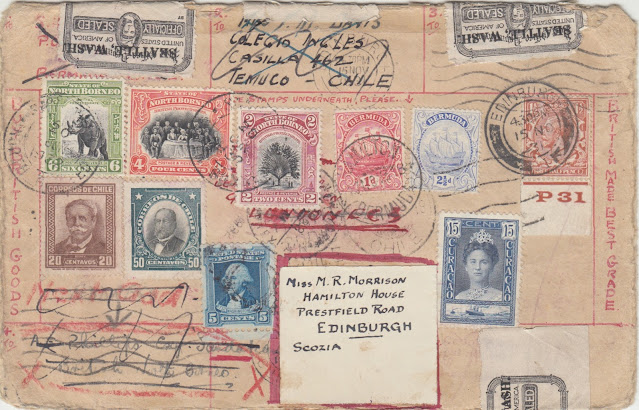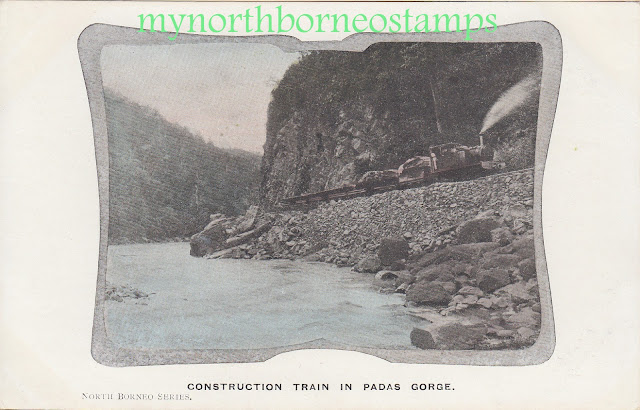The following cover was actually addressed to W H Elton's son. It was overpaid by 4c, 2c being the local rate. These philatelic covers were sold to collectors to raise money for building St Michael's Church at Sandakan.
This was personally written by W H Elton in one of the colonial reports sent back to Britain:
I left home in 1888 my commission was to go as pioneer
chaplain to the Officers of the British North Borneo Ser rice, and other
Europeans in the State and to do what Mission work was possible besides among
the Natives of the country.
On my arrival 1 made Sandakan, the capital, the head quarters
of the Mission and made up my mind to occupy in the first instance, the three
chief seaport towns viz. Sandakan, Kudat, and Labuan. The first year was spent
in building a Vicarage, a temporary School- Church in Sandakan, in visiting the
other stations on the Coast and in travelling up all the rivers to see the
Planters and christen their children. At the close of the first year Mr.
Richards arrived from home. He was the first Missionary to follow me to North
Borneo.
By this time there was a considerable number of Chinese
Christians in the Territory most of whom were located at Kudat, and it was
arranged for Mr. Richards to take up work among these Chinese, and with this
view he went to China for eight months to study the language. During his
absence I went to Kudat and built a School-Church and two rooms of a Vicarage
having promised him to have them ready for him on his return. It is interesting
to note that it was the officers and men of the Navy who started these
buildings in Kudat with a donation of $100.
While the buildings at Kudat were in course of erection the
pretty little Church at Labuan, which had been built during Bishop McDougall's
episcopate was burnt down in a jungle fire. As soon as I heard, of it I went to
Labuan and built a School- Church in which the services have since been held.
During the year 1892 another worker arrived, Mr. Patrick, who
was appointed, English Master of the Sandakan Boys' School, which by that time
numbered fifty scholars of various nationalities, twenty-five of whom were
boarders and formed the surpliced choir in Sandakan Church.
On the 29th September, 1893, an important step was taken in
the laying of the foundation stone of the permanent Church in Sandakan by
Governor Creagh, Five years had been spent in cutting down an immense hill at
the back of the Vicarage, in order to obtain sufficient area for the Church.
During those five years the late, Rev. Brynne Belcher had been collecting funds
in England for a permanent Church in Sandakan and had remitted £50 a year for
the purpose. I was about to begin a brick church when we discovered excellent
stone within two miles of Sandakan, so we at once opened a quarry and
determined to build in stone. Having obtained plans of a Gothic Church from a
first-rate architect I began to instruct the Chinese in the art of building and
by Easter Day 1898, just ten years after my arrival in the country, the
Chancel, Vestries and Organ Chamber were completed at a cost of $16,822. It is
interesting to note that this is the first stone building in Borneo, After ten
years of incessant work without a change my health began to suffer, so after
the consecration of the Chancel, I suspended building operations and went to
England for a cooling. While I was at home I collected some money for the Nave
and Transepts of the Church and these have now been in course of erection for
four years and are about half finished.
Since my return from home ice have also
been collecting money for a permanent Girls School and, thanks to the exert ions
of Mrs. Birch, the handsome new building will be opened free of debt in about a
month. So we now have three Boys' Schools and one Girls' School. All the
education of the country is being carried on by the Church of England and the
Church of Rome, the Chartered Company having not, as yet, opened any Schools.
The money for all these buildings viz.
four in Sandakan, four in Kudat and one in Labuan has been raised by voluntary
subscriptions amounting in all to $40,000.





























.jpg)




